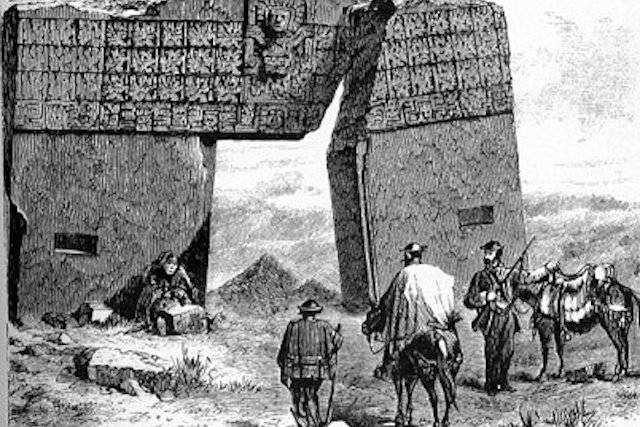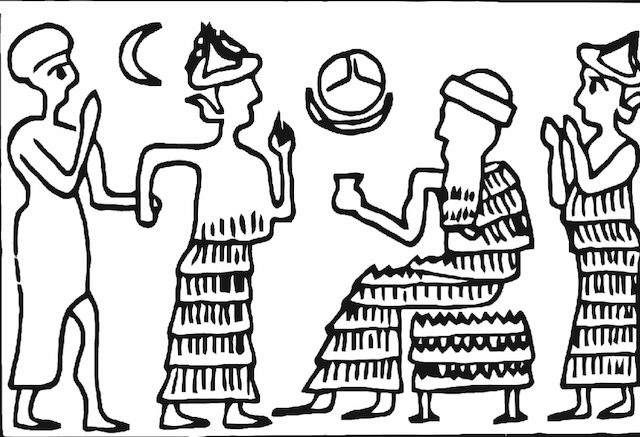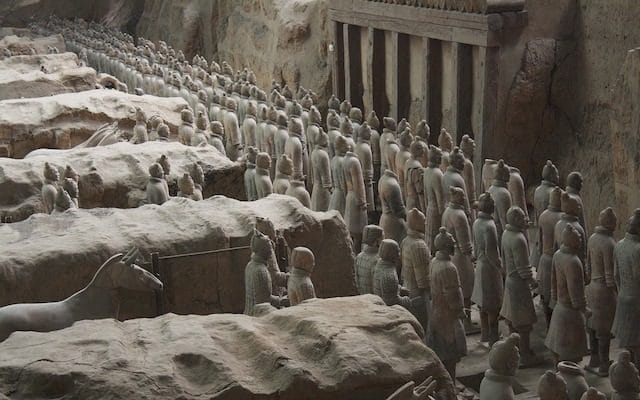From ancient Egypt to Rome to Britain, history is full of great empires that have had a profound impact on the history of human civilization, though we are not here to talk about them. Instead, we are more interested in the empires and civilizations that have fallen out of the history books, perhaps because many of them existed so long ago that we have kind of forgotten about them.
10. Mauryan Empire

Lasting from about 321 to 185 BCE, the Mauryan Empire was the first empire to cover much of the Indian subcontinent, with its capital at Pataliputra, near modern-day Patna. It was founded by Chandragupta Maurya, who was succeeded by his son Bindusara and then by Emperor Ashoka, also sometimes called Ashoka the Great.
The rise of the Mauryan Empire to power began after the overthrow of the Nanda dynasty. During the reign of Ashoka, the empire expanded through military conquest and diplomacy, leading to long periods of relative prosperity for the subcontinent. The region had an efficient Mauryan administrative system, which included a network of officials and an effective taxation system. The rulers encouraged trade, especially along the Silk Road, and engaged in economic activities such as agriculture, manufacturing, and trade on a large scale.
9. Caliphate of Cordoba

From January 929 to 1031, the city of Cordoba in Spain served as the capital of one of the most successful Islamic states in history, also known as the Caliphate of Cordoba. Founded after the conquest of Christian kingdoms in the region, it would become one of the most successful states in the larger Islamic empire, and Cordoba would become the center of arts and sciences on the Iberian Peninsula.
This period is considered one of Spain's golden ages, when libraries, colleges, and public schools were established throughout the territory to encourage academic learning. Science, architecture, and poetry flourished in Cordoba during this time, making it one of the centers of learning and scholarship in the large Islamic empire. It was also a successful trading city, making Spain the most populous and prosperous country in Europe at the time.
8. The Xiongnu Empire

The Xiongnu Empire was a nomadic empire that existed from the third century BCE to the first century CE. It was primarily located in Central Asia and extended across much of the Eurasian Steppe, including modern-day Mongolia, Kazakhstan, and parts of China and Russia. The Xiongnu Empire was founded by various nomadic tribes, with the Xiongnu people emerging as the dominant force under their leader Modu Chanyu, who came to power after the assassination of his father in 209 BCE.
The empire experienced many periods of prosperity and expansion during its reign. The Xiongnu were skilled horsemen and fierce warriors, allowing them to conquer vast territories and create a network of client states across Central Asia for over 500 years. They controlled key trading centers, facilitated cultural exchange, and conducted diplomacy with neighboring powers such as the Han Dynasty in China. The Xiongnu Empire would also have a significant impact on Chinese history, as frequent conflicts and alliances would shape the region’s geopolitical landscape for years to come.
7. Tiwanaku Empire

Tiwanaku was a pre-Columbian civilization that existed from approximately 400 to 900 AD in the southern Andes of South America. It was primarily centered around the southern shore of Lake Titicaca, covering parts of modern-day Bolivia, Peru, and Chile. The empire was named after its capital, Tiwanaku, and was responsible for the construction of impressive architectural structures and intricate stone carvings throughout the Andes region.
It was founded by the Tiwanaku people, who created a centralized government led by priests and nobles, as well as an effective system of governance. The empire experienced significant growth and influence throughout its existence, which helped spread its cultural and economic influence to neighboring societies. The Tiwanaku Empire grew into a powerful state due to its strategic location along trade routes and its ability to use known technologies to increase agricultural productivity. This was so impressive that at its peak, Tiwanaku’s terraced farms and fields could feed over 60,000 people.
6. Assyrian Empire

The Assyrian Empire existed as an ancient Mesopotamian civilization from approximately 900 to 600 BCE, primarily in what is now northern Iraq and southeastern Turkey. The empire was founded and expanded by a succession of powerful Assyrian rulers, including Tiglath-Pileser I, Ashurnasirpal II, and Sargon II.
The Assyrian Empire experienced many golden periods and eras of military dominance over its regional rivals, emerging as one of the most influential civilizations in the region's history. It established itself as a formidable empire through a series of military conquests and campaigns of conquest, and its success was largely due to its highly organized military structure. Assyrian armies were adept at using modern tactics and engineering techniques to win wars, especially with their expertise in sieges and the construction of massive fortified cities.
During this period, the region under Assyrian control also became a center of trade and commerce, as it developed a complex administrative and tax collection system, legal codes, and a well-structured bureaucracy.
5. Yuan Empire
The Yuan Empire was a continuation of the Mongol Empire in China, established after the Mongol defeat of the Song Empire in 1271. It was located in East and Central Asia, including areas that are now part of modern-day China, Mongolia, and other neighboring regions.
The empire reached its peak of power and influence under Kublai Khan, the grandson of Genghis Khan, who successfully conquered China and founded the Yuan Dynasty, becoming its first emperor. It was characterized by a strong centralized government, with Mongols typically forming the ruling elite and Chinese scholars and bureaucrats performing administrative functions.
During this period, China experienced an era of prosperity and cultural exchange thanks to international trade, especially along the Silk Road, which connected East Asia with Europe and the Middle East. Unfortunately, the empire was short-lived, as the Yuan Dynasty was overthrown in 1368 by a popular uprising known as the Red Turban Movement.
4. The Empire of Mali
From about the 13th to the 16th centuries BC, the Mali Empire was one of the richest and most prosperous kingdoms in the world. Founded by King Sundiata Keita, it was based in what is now the Republic of Mali in West Africa, and its influence extended into remote regions of Africa and beyond.
Mali was primarily a trading empire, founded by the unification of several smaller states into a single entity. Under Mansa Musa, who ruled in the 14th century, the empire reached the height of its wealth and influence, a period that many modern historians recognize as one of the region's golden ages.
Mali and the entire West African region prospered during this period, as the empire controlled many important trading outposts, especially along the trans-Saharan route, which included valuable items such as gold and salt. Mali’s position as a major trading center facilitated cultural exchange with distant empires, leading to a renaissance in the arts, science, architecture, and other fields. Cities such as Timbuktu emerged as centers of learning and academia, attracting students and scholars from around the world.
3. Kingdom of Kush

The Kingdom of Kush was an ancient African civilization of the Nile Valley that existed from approximately 1070 BCE to 350 CE, making it one of the longest-lived empires in history. It was located in the ancient region now known as Nubia, and included modern-day Sudan and part of Egypt. The kingdom was founded by the Nubian people after gaining independence from Egypt, and its capital moved between cities such as Napata and Meroe throughout its history.
Kush initially emerged as a powerful state through its trade along the Nile River, as it benefited from the exchange of goods and ideas between sub-Saharan Africa and the Mediterranean region. The kingdom's influence expanded when it conquered Egypt, creating the 25th Dynasty and pharaohs ruling from 747 to 656 BC.
Throughout this period, the Nile region was known for its wealth, much of which came from the trade in gold, ivory, ebony, and other valuable resources from the region. The kingdom eventually adopted aspects of Egyptian culture and religion while maintaining its unique Nubian identity.
2. Khmer Empire
The Khmer Empire was a powerful Hindu-Buddhist civilization in Southeast Asia that lasted from 802 to 1431 CE. It was primarily centered in modern-day Cambodia, with its influence extending into parts of Thailand, Laos, and Vietnam.
Under Jayavarman II, the empire's founder, it became one of the most prosperous and powerful states in the region, reaching its peak during the reign of Suryavarman II around 1122 CE. The empire's success was aided by an advanced agricultural system, including the construction of complex irrigation networks and reservoirs.
One of the most notable innovations of the Khmer Empire was the construction of Angkor Wat, often called the largest religious monument in the world. The empire's capital, Angkor, was also known for its magnificent temples, intricate carvings, and extensive urban infrastructure.
1. Achaemenid Empire
At its peak, the ancient Iranian Achaemenid Empire stretched from Egypt and Libya to northern India and Central Asia, making it the largest ancient empire we know of. Founded around 550 BC by Cyrus II, also called Cyrus the Great, it was home to over 44% of the world's population by 475 BC and may even be considered an early example of a global multi-ethnic empire.
The Achaemenid Empire was known for many great innovations, including and especially its extensive and interconnected road network. Many cities throughout the region developed into sprawling metropolises, largely due to the effective rule of a number of famous kings of the Achaemenid dynasty. It remained a stable, formidable power in Eurasia until 331 BC, when the empire was completely conquered by the armies of Alexander.













Оставить Комментарий